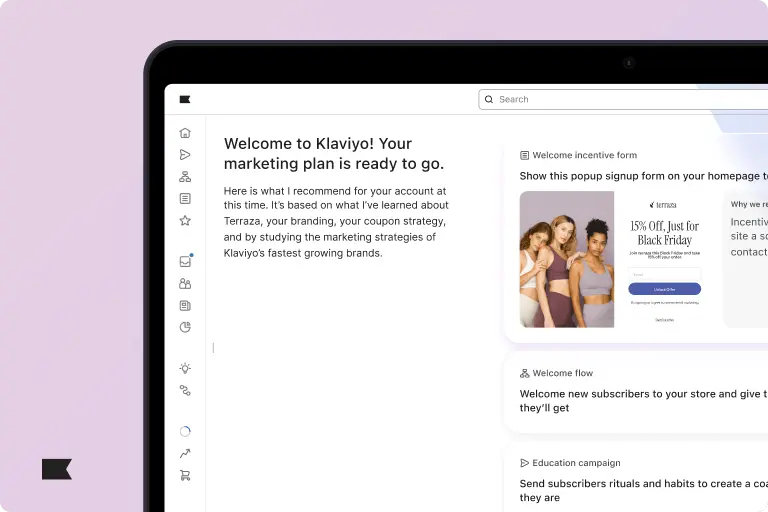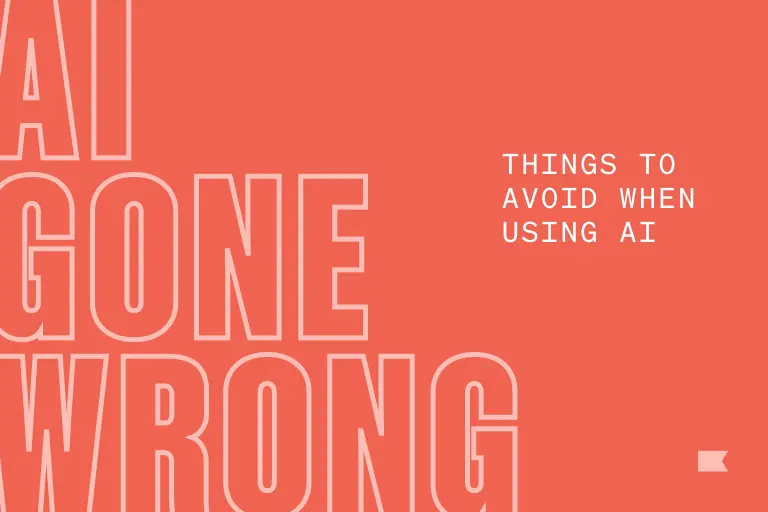How to use Klaviyo AI this Black Friday
Black Friday has changed. It’s less known for stampedes and (literal) doorbuster sales.
The doorbusters are digital now, and the stampedes have turned into billions of digital data points and emails. (During peak hours of Black Friday 2024, Klaviyo users sent 420 million messages!)
The internet has become our primary Black Friday shopping destination.
So how can brands adapt, and drive maximum revenue during the highest-volume shopping weekend of the year?
By leveraging AI—and it’s already happening.
Klaviyo AI makes advanced techniques easier to access. It’s a time saver.
Here’s our guide to using the latest Klaviyo AI tools during the peak season rush, based on insights from Klaviyo insiders and customers—so you can optimize, analyze, and execute more quickly, and ultimately drive more revenue.
1. Boost deliverability with reputation repair AI
- What reputation repair AI does: Automatically generates a segment of disengaged profiles for exclusion from sends, and provides a real-time deliverability score on a scale from 0 to 100. Gradually, it adjusts the disengaged segment parameters until your account achieves a “good” (75+) deliverability score.
- When to use it for BFCM: During your peak season event—no need to toggle it on unless you previously disabled it.
- Example BFCM use case: During BFCM, if your score drops below 50 (poor), reputation repair AI will automatically kick in. You’ll see a new prompt in the campaign builder to exclude disengaged profiles to boost your deliverability score.
- Proof it works IRL: Reputation repair AI allows customers to seamlessly repair their email sender reputation without interrupting their campaign plans or reorganizing their segment structures,” Aguilar explains. “The system automatically calculates and adjusts repair in real time, reducing the delays that may be caused by manual work. It also allows for better consistency and faster repair.”
2. Create multi-branch flows, fast, with Flows AI
- What Flows AI does: Builds automated flows based on natural language text prompts.
- When to use it for BFCM: In Q3, to build out advanced flows that need internal approvals and net-new creative. Or in Q4, to build a flow quickly in a pinch.
- Example BFCM use case: Flows AI can help you “streamline” post-purchase flow creation, Aguilar says. You may want to serve different messaging to repeat buyers vs. one-time buyers or to people with different AOV ranges, and even based on the specific SKUs someone purchased. Flows AI can help you do all that in a single flow, which simplifies performance reporting and ensures no one gets multiple, redundant automations when they purchase multiple products.
3. Target any customer you can describe with Segments AI
- What Segments AI does: Builds segments based on natural language text prompts.
- When to use it for BFCM: In early November, Aguilar says. That way you can use it to build out segments for peak season campaigns, and schedule sends in advance.
- Example BFCM use case: Use Segments AI to create re-send segments in bulk—so it’s easy to send each BFCM campaign twice in a day, the second time only to recipients who haven’t purchased yet.
- Proof it works IRL: “The Klaviyo UI makes segmentation way easier than our previous software,” says Sreevats R., product manager at Svenfish. The team can easily send their customers frequent, hyper-personalised campaigns. In August 2024, they sent 27 targeted campaigns, nearly one a day—driving nearly 70% of their total ecommerce revenue with Klaviyo.
- Bonus tip: Specify that you want to send to subscribers who “accept marketing” in your Segments AI prompt, advises Neil Gogate, principal customer success manager at Klaviyo. Otherwise, you could send marketing messages to users who haven’t yet consented to that.
4. Streamline copywriting with SMS, Email, and Reviews AI
- What these 3 tools do: Generate SMS copy, email subject lines and targeted templates, and responses to customer reviews in seconds.
- When to use it for BFCM: Start testing these tools in Q3 and see how the copy performs with your subscribers, Gogate recommends—before the pressure and visibility of Q4.
- Example BFCM use case: If you want to ramp up SMS volume during BFCM, AI can help you do that without hiring an extra copywriter. “SMS AI can help save you time and give you really creative, on-brand recommendations,” says Aguilar.
5. Level up your A/B testing with personalized campaigns AI
- What personalized campaigns AI does: Offers an alternative to one-size-fits-all A/B testing. Instead of sending one winning version to the bulk of recipients, AI determines the best version for each individual subscriber and sends it instantly.
- How it works: Klaviyo AI looks at profile attributes like location, engagement with past campaigns, customer lifetime value (CLV), average time between purchases, and more to predict which version each customer will engage with.
- When to use it for BFCM: Start testing this feature in Q3 to gather insights about your subscribers.
- Example BFCM use case: Results from personalized campaigns AI can help inform your segmentation and messaging over peak season. For example, you might learn that customers in London with a historical CLV above £200 may convert better when they see lifestyle imagery—and you can make sure they see exactly that during BFCM.
6. Take 30 seconds to grow your list with forms display optimization
- What forms display optimization does: Optimizes the timing and placement of sign-up pop-ups on your site by testing AI-generated alternatives against each other. “It involves no lift whatsoever,” Aguilar says. “It literally takes 30 seconds to turn on.”
- When to use it for BFCM: Start now, Aguilar advises. Testing can take 4–6 weeks, and you’ll ideally have the winning display configuration live before BFCM.
- Example BFCM use case: Run forms display optimization in early Q3, then use the winning version to grow your list before BFCM. (This works especially well for brands that run a back-to-school sale.) Then, owned marketing can play a bigger role in your marketing mix during peak season—and you can reduce spend on pricey holiday ads.
- Proof it works IRL: Natural skincare brand Tata Harper ran forms display optimization and saw 65%+ growth in submissions across both their sign-up pop-ups—and 27% growth in their welcome flow revenue.
7. Refine your omnichannel strategy with AI-powered channel affinity
- What AI-powered channel affinity does: Identifies the optimal mix of channels for each customer profile, across all Klaviyo channels—email, SMS, push, and beyond.
- When to use it for BFCM: Before peak season, use AI-powered channel affinity to customize your multi-channel flows. During peak season promo itself, use it to target campaigns.
- Example BFCM use case: Send a limited-time offer to engaged customers on the channel they engage with most, with segmentation based on channel engagement preference.
8. Unearth trends in customer feedback with review sentiment AI
- What review sentiment AI does: Tracks and analyzes overarching trends in your customer reviews—good and bad. It can help you identify sentiment trends within a specific date range, or see how sentiment tilts around specific topics.
- When to use it for BFCM: Enable this ASAP, so you can analyze all the new product reviews from peak season customers.
- Example BFCM use case: Look at sentiment for the window of time when orders placed during BFCM got delivered. Review sentiment AI will help you assess the overall success and alignment of your peak season marketing, product, and logistics.
- Why we made it: “Reviews are a goldmine, but when you have hundreds of products and thousands of reviews, it takes hours to sift through all the feedback,” says Jessica Schanzer, former lead product marketing manager at Klaviyo. “Klaviyo AI gives you quick insight into what people are saying about your brand at scale.”
9. Send AI-personalized recommendations at scale with dynamic product feeds
- What dynamic product feeds do: Recommend a carousel of products each customer is most likely to buy next, based on what they’ve ordered in the past and how they’re similar to other customers.
- When to use it for BFCM prep: Start A/B testing in Q3, to see where personalized feeds—as opposed to feeds of your new or most popular products—drive the most lift. (Aguilar recommends mixing dynamic feeds with other types of feeds, so recommended products always feel novel.)
- Example BFCM use case: Use dynamic product feeds in post-purchase flows during your BFCM sale. With the limited-time sale creating urgency, a shopper may place a second order based on a personalized recommendation.
- Proof it works IRL: “Dynamic product feeds help propel that next purchase during a season where everyone is buying,” says Aguilar—improving CLV and reducing churn.
10. Target churn risks and big spenders with predictive analytics
- What predictive analytics does: Forecasts next order date, CLV (historical, predicted, and total), and churn risk for each customer based on their behavioral data.
- When to use it for BFCM: “There’s never a bad time to use predictive analytics,” says Aguilar—you can use it to create segments in the months leading up to BFCM, or on the fly during the weekend itself.
- Example BFCM use case: Create a segment of customers whose expected date of next purchase falls on or near BFCM weekend, and target them with an extra dose of seasonal messaging before and during your sale. “Expected date of next purchase does really well around peak season,” Aguilar says.
- Proof it works IRL: ICONIC LONDON saw a 42% increase in CRM revenue in under a year after switching to Klaviyo and using Klaviyo’s AI and predictive analytics to build intelligent flows and campaigns.
11. Assess your performance vs. the competition with benchmarks
- What Klaviyo benchmarks does: Empowers you to compare your Klaviyo performance to results from the 100 Klaviyo accounts most similar to yours (all anonymized, of course).
- When to use it for BFCM: After your sale, to assess performance.
- Example BFCM use case: After the weekend closes out, look at how your BFCM performance stacks up against peer benchmarks. You’ll see where you outdid competitors, and where you (realistically!) have room to improve.
- Proof it works IRL: Klaviyo benchmarks helps the team at Chelsea Peers contextualize their performance more deeply. “I’m obsessed with the benchmarks. They make it easy to see where we’re excelling and where we need to improve without sifting through endless data. It’s game-changing,” says Caroline Trembaluk, customer service and relationship coordinator at Chelsea Peers.
Delegate BFCM execution and analysis to Klaviyo AI in 2025
During the peak season rush, Klaviyo AI can streamline your marketing operations.
“A lot of times, Klaviyo customers are trying to be very prescriptive about how they’re targeting,” says Gogate—specifying their audiences down to the tiniest detail.
That can get quite time-consuming, especially when you’re exporting data and running manual calculations, Aguilar adds.
But you don’t have to make every decision about your segments, your forms, and even your creative—your customers’ behavior and your brands’ performance data can guide those calls now, too.
“With Klaviyo AI, you don’t have to dot every i and cross every t,” Gogate says. “You can be a little bit more loose and open, in a way that’s going to create more efficiency.”

Related content

Learn how to use K:AI Marketing Agent to plan, launch, and optimize your BFCM campaigns faster—boosting efficiency, personalization, and sales this holiday season.

Turn product photos into campaign-ready images in seconds with Klaviyo Remix. Discover 5 AI product photo editing use cases to kickstart your creative marketing strategy.

Discover the common AI pitfalls for ecommerce businesses and customer relationships—and how to fix them.